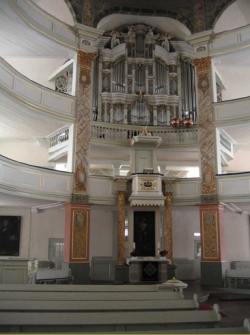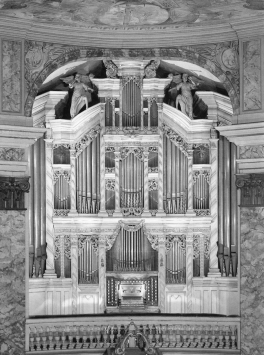


Waltershausen, Gotteshilfkirche

Tobias Heinrich Trost 1722-1735
State of preservation: Partially unfinished the organ suffered no major changes and over the centuries was rated a rare masterpiece. Still by Trost are: the case including front pipes, majority of stops, wind chests, playing action including borrowings except the pedal keyboard). Restoration in 1993-98.
Music sample:
J.S. Bach : Toccata in d ("dorian") BWV 538
played by Theophil Heinke
The Waltershausen organ is the biggest of all by Tobias Heinrich Trost. Here he tried to realise his sound ideas almost without any compromise. Understandably he faced enormous problems. One example of this: The organ case was too high for the space available, and instead of reducing the organ he demanded the lowering of the organ gallery by almost two meters (see right picture). Trost's work strain finally led to a halt shortly before finishing the instrument which by using ranks already made but not put in place, was done by an unknown organ maker, probably Trost's journeyman. Because of this there was no examination and celebration as usual. But the anger of town and parish superiors changed over the times into rightful pride of one of the most remarkable organs of its time.
The organ has plenty of rather unusual technical features hardly used by anyone else but Trost, like double pallets for a large number of main organ stops to be borrowed for the pedal. A link between stops Vox humana 8’ and Hohlflöte 8’ (OW) allows the flute stop to be played alone while the reed stop only combined, obviously a very personal sound idea. Trost proceeded to several limits of the technically possible: providing a constant wind for the big amount of ranks demanding a high amount of wind (eg like the many pedal reeds) was a big problem for Trost and required a lot of refinements up to the specific construction of channels and wind chests to achieve a working result.
Specification:
III+P; manuals C-c3; pedal C-d1
HW:
Portun-Untersatz 16’
Groß Qvintadena 16’ (->P)
Principal 8’
Gemshorn 8’
Viol d’Gambe 8’
Portun 8’ (->P)
Qvintadena 8’
Unda maris 8’
Octava 4’ (->P)
Salicional 4’
Röhr-Flöta 4’ (->P)
Celinder-Qvinta 3’
Sesqvialtera (22/3’+13/5’) 2f.
Super-Octava 2’
Mixtura 2’ 8f. (p1993; ->P)
Fagott 16’ (p1993)
Trompetta 8’
BW:
Gedackt 8’
Nachthorn 8’
Principal 4’
Flöte douce 4’ 2f.
Nachthorn 4’ (p1993)
Gemshorn 4’ (tlw. p1993)
Spitz-Qvinta 3’
Nassad-Qvinta 3’
Sesqvialtera (22/3’+13/5’) 2f.
Octava 2’
Mixtura 2’ 4f. (p1993)
Hautbous 8’
OW:
Flöte Dupla 8’
Vagarr 8’ (p1993)
Hohlflöte 8’ (*)
Flöte travers 8’ (überblasend, Klang 4’; p1993)
Lieblich Principal 4’
Geigen-Principal 4’ (own pallet box over the console)
Spitzflöte 4’
Gedackt-Qvinta 3’ (p1993)
Wald-Flöte 2’
Vox humana 8’ (p1993; * coupled to Hohlflöte 8’)
P:
Groß Principal 16’
Subbaß 16’
Violon-Baß 16’
Qvintadenen-Baß 16’ (borrowed from HW)
Octaven-Baß 8’
Viol d’Gamben-Baß 8’ (borrowed from HW)
Portun-Baß 8’ (borrowed from HW)
Celinder-Qvinta 6’
Super-Octava 4’ (borrowed from HW)
Rohr-Flöten-Baß 4’ (borrowed from HW)
Mixtur-Baß 2’ 6f.(borrowed from HW)
Posaunen-Baß 32’ (p1993)
Posaunen-Baß 16’
Trompetten-Baß 8’
Couplers OW/HW (hooks), BW/HW (pusher), HW/P (wind), BW/P
(hooks), Tremulant BW, Tremulant manuals, 2 Zimbelsterne (in C/G), push stop, Calcant
© Greifenberger Institut für Musikinstrumentenkunde | info@greifenberger-institut.de




